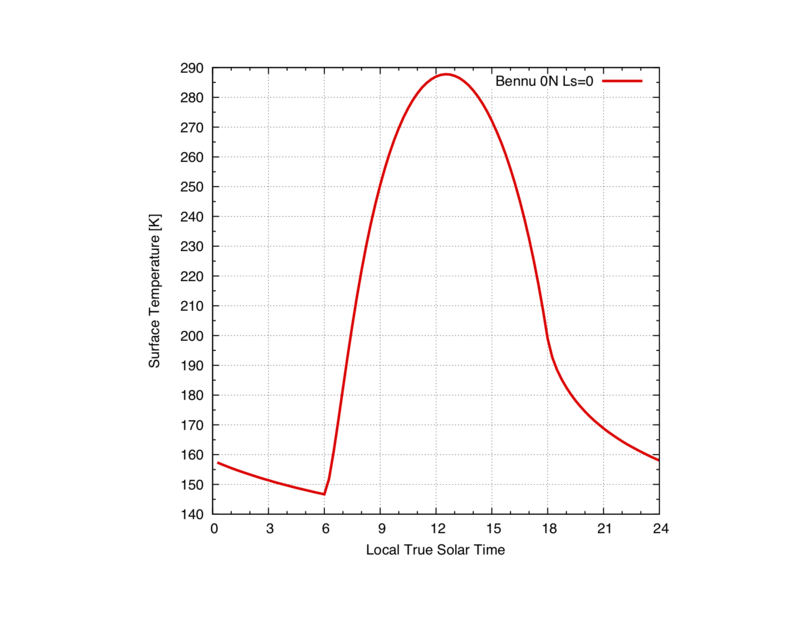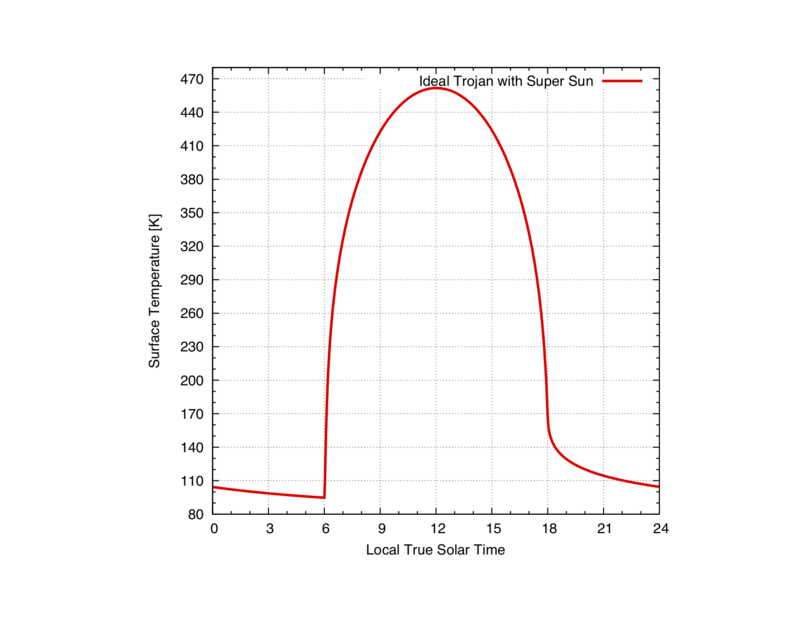KRC for Asteroids
(→Notes) |
|||
| Line 1: | Line 1: | ||
==Notes== | ==Notes== | ||
| − | Basalt is the default material for asteroids ( | + | Basalt is the default material for asteroids (Mat1 = "basalt"), and T_user = 220 (temperature at which the inertia is defined). |
| Line 28: | Line 28: | ||
For these bodies, directly run KRC using the body's name as follow: | For these bodies, directly run KRC using the body's name as follow: | ||
| − | : body = " | + | : body = "BODY_NAME" |
For example: | For example: | ||
| − | out = krc(lat = 0., INERTIA = 50., T_user = 220., LKofT = "T", body = " | + | out = krc(lat=0.,INERTIA=50.,T_user=220.,LKofT="T",body="Bennu",ls=0.) |
| − | [[Image:Bennu.png| | + | [[Image:Bennu.png|800px]] |
For other bodies -not in the list above-, the user needs to generate the rotational matrix. First, run PORB to create a structure that can be ingested to generate the orbital rotation matrix. The following arguments are needed: | For other bodies -not in the list above-, the user needs to generate the rotational matrix. First, run PORB to create a structure that can be ingested to generate the orbital rotation matrix. The following arguments are needed: | ||
| Line 44: | Line 44: | ||
:i: Inclination of mean orbit to ecliptic in degrees (Default=0) | :i: Inclination of mean orbit to ecliptic in degrees (Default=0) | ||
| − | :node: Longitude of the | + | :node: Longitude of the ascending node in degrees (Default=0) |
:per: Argument of perihelion in degrees (Default=0) | :per: Argument of perihelion in degrees (Default=0) | ||
| Line 64: | Line 64: | ||
Then run generic_porb() with these arguments, for example: | Then run generic_porb() with these arguments, for example: | ||
| − | tmp = generic_porb(e = 0, a = 1., i = 1.3, node = 100.4, peri = 293.9, m = 79.6, rot_per = 200., polera = 273.8, poledec = 0., merid = 7.7, period = 4332.5, name = "IdealJupiterTrojan") | + | tmp = generic_porb(e=0,a=1.,i=1.3,node=100.4,peri=293.9,m=79.6,rot_per=200.,polera=273.8, poledec=0.,merid=7.7,period=4332.5,name="IdealJupiterTrojan") |
| − | Then run KRC using this new body as the "body | + | Then run KRC using this new body as the "body": |
| − | out = krc( lat = 0., lon = 0, INERTIA = 20., ALBEDO =.05, LKofT = "F", body = tmp | + | out = krc(lat=0.,lon=0,INERTIA=20.,ALBEDO=.05,LKofT="F",body=tmp) |
This case predict surface temperature for a new body named "IdealJupiterTrojan". | This case predict surface temperature for a new body named "IdealJupiterTrojan". | ||
| − | [[Image:Exoplanets.png| | + | [[Image:Exoplanets.png|800px]] |
Surface Temperature for an Ideal Trojan whose orbital parameters are specified ("Trojan with Sun"), as well as the same body with a warmer Sun (SOLCON = 2722.) | Surface Temperature for an Ideal Trojan whose orbital parameters are specified ("Trojan with Sun"), as well as the same body with a warmer Sun (SOLCON = 2722.) | ||
Revision as of 19:45, 1 April 2020
Notes
Basalt is the default material for asteroids (Mat1 = "basalt"), and T_user = 220 (temperature at which the inertia is defined).
Orbital parameters have already been processed for some asteroids:
Annefrank
Bennu
Braille
Ceres
Gaspra
Itokawa
Lutetia
Mathilde
Pallas
Vesta
For these bodies, directly run KRC using the body's name as follow:
- body = "BODY_NAME"
For example:
out = krc(lat=0.,INERTIA=50.,T_user=220.,LKofT="T",body="Bennu",ls=0.)
For other bodies -not in the list above-, the user needs to generate the rotational matrix. First, run PORB to create a structure that can be ingested to generate the orbital rotation matrix. The following arguments are needed:
- e: Eccentricity (Default=0)
- a: Semi-Major Axis in AU (Default=1)
- i: Inclination of mean orbit to ecliptic in degrees (Default=0)
- node: Longitude of the ascending node in degrees (Default=0)
- per: Argument of perihelion in degrees (Default=0)
- m: Mean Anomaly at epoch in degrees (Default=0)
- rot_per: siderial rotation period in hours (Default=23.9345)
- polera: Right Ascension of the pole in degrees (Default=0)
- merid: Prime meridian at epoch in degrees (Default=0)
- poledec: Declination of the pole in degrees (Default=0)
- period: Sideral orbital period in Earth days (Default=365.256)
- name: Body name (default ="None")
Then run generic_porb() with these arguments, for example:
tmp = generic_porb(e=0,a=1.,i=1.3,node=100.4,peri=293.9,m=79.6,rot_per=200.,polera=273.8, poledec=0.,merid=7.7,period=4332.5,name="IdealJupiterTrojan")
Then run KRC using this new body as the "body":
out = krc(lat=0.,lon=0,INERTIA=20.,ALBEDO=.05,LKofT="F",body=tmp)
This case predict surface temperature for a new body named "IdealJupiterTrojan".
Surface Temperature for an Ideal Trojan whose orbital parameters are specified ("Trojan with Sun"), as well as the same body with a warmer Sun (SOLCON = 2722.)

